Think organic citrus doesn’t need washing? Here's the dirty truth hiding on those fragrant peels

The zest of citrus fruits (lemons, oranges, limes, tangerines) is one of the most fragrant and versatile parts of the fruit: it enhances the flavor of desserts, cocktails, savory dishes, and preserves. But there is an often-overlooked detail that can compromise aroma and safety: washing citrus fruit well before grating the zest.
In this article you will find out:
- why it is risky to use unwashed zest
- what food waxes are
- how to properly wash citrus fruits and lemons
- whether organic products are really safer
Citrus peel: concentrated aroma (but also contamination)
The colorful outer part of citrus fruits, called flavedo, is rich in essential oils responsible for the intense fragrance we so enjoy in cooking. However, it is also the most exposed to external contaminants.
Substances that can settle on the peel include:
- agricultural pesticide and fungicide residues
- protective food waxes (including synthetic ones)
- dust, bacteria, mold and smog absorbed during transport and storage
Grating a peel without thoroughly washing the citrus fruit means transferring all of this directly to the plate.
Waxes on citrus fruit: what they are for and why to remove them
Citrus fruits on the market, especially in supermarkets, are often treated with protective waxes to keep them shiny and extend their shelf life.
These waxes can be:
- natural (such as beeswax, shellac or carnauba)
- synthetic (with chemical additives)
Although approved, waxes:
- cover the flavors of the peel
- alter taste in contact with heat (baked goods, jams)
- may contain substances unsuitable for direct consumption in large quantities
EFSA reports frequent use of fungicides such as thiabendazole or imazalil on post-harvest treated citrus fruit: washing the peel helps limit intake.
How to properly wash lemons, oranges and other citrus fruits
A simple rinse is not enough. Here is an effective method for removing waxes, pesticides and bacteria:
Natural step-by-step method:
- Rinse with warm water to remove visible dirt.
- Scrub vigorously with a vegetable brush or your hands.
- Soak in a solution of 1 liter water + 2 tablespoons baking soda for 10-15 minutes.
- Rinse thoroughly with running water.
- Dry well before grating.
Alternatively, use half a cup of white vinegar per liter of water or specific fruit and vegetable cleaners.
Are organic citrus fruits safer?
Organic citrus fruits, grown without chemical pesticides and free of synthetic waxes, are generally safer for eating the peel. However, even organic ones should be washed because:
- they may contain soil or insect residues
- they are exposed to weathering and smog
- washing helps to better release natural flavors
Organic is a healthier choice, but it does not exempt from proper hygiene.
Conclusion: washing the peel is a small but powerful gesture
Washing citrus peel well before grating is a simple but crucial habit to enhance flavor and ensure food safety. It's not just about hygiene-it's about respect for the ingredients and attention to the end result.
In cooking, it's the details that make the difference. And a clean, fragrant and safe peel can transform any dish.
 Daniele Mainieri
Daniele Mainieri
Comments